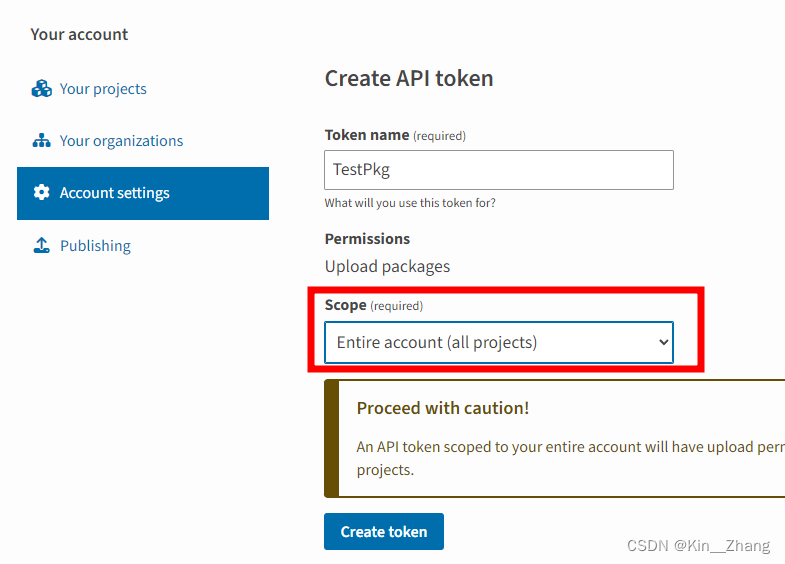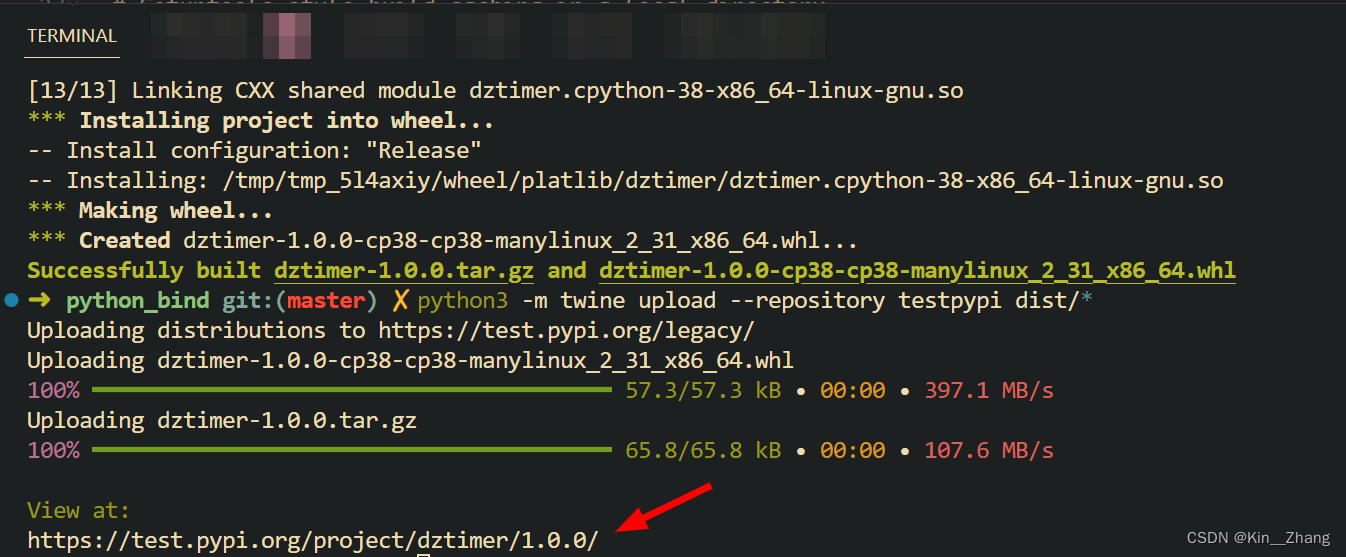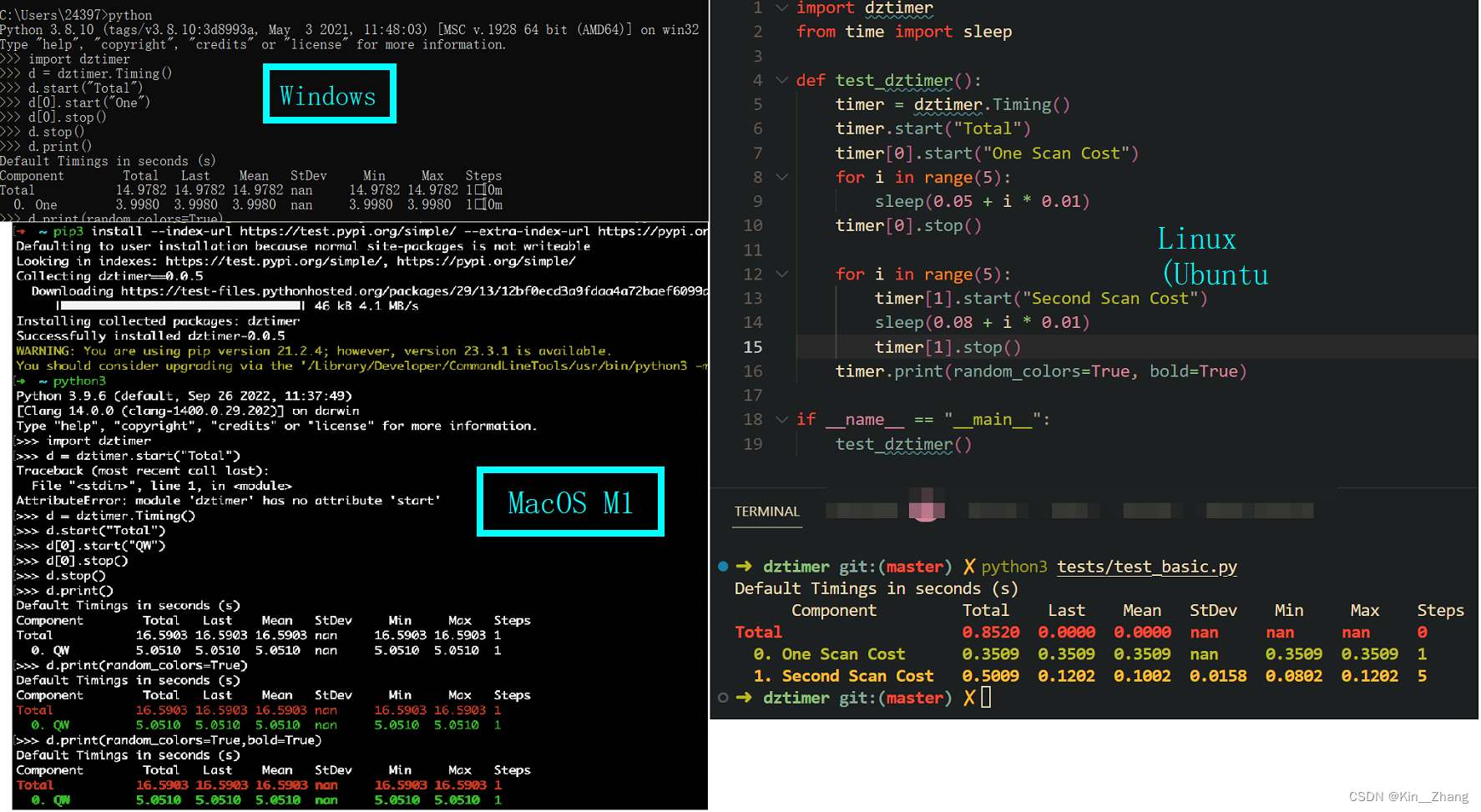【教學】cpp轉python Nanobind 實踐 加速輕量版 pythonbind11
主要是嘗試一下把c++這邊的函數封裝打包給python用,選擇nanobind的原因是:1. 優化速度快,2. 生成二進位制包小,不過pythonbind11是更為廣泛知道的,nanobind也是pythonbind11作者後續做的,可以檢視作者寫的 why another binding libaray?
總結一下就是:nanobind 同樣是一個用於建立 C++ 和 Python 之間繫結的工具,它的目標是簡化和加速繫結生成過程。與 pybind11 相比,nanobind 的不同之處在於它專注於 較小的 C++ 子集,提供更高效的內部資料結構和效能優化,並引入了一些便利性和質量改進的新功能。
參考資料:
- official code: https://github.com/wjakob/nanobind
- official docs: https://nanobind.readthedocs.io/en/latest/
- 非常簡單的範例:https://github.com/wjakob/nanobind_example/tree/master
- 本篇博文的範例程式碼:dztimer (which 耗時 小張同學 3小時找bug)
1. 安裝 Install & 查詢 Find
注意不同的安裝方式在 cmakelist.txt 的寫法會不一樣,下面會分別舉例:
# 1. pip install
python -m pip install nanobind
# 2. conda install
conda install -c conda-forge nanobind
# 3. from source
git submodule add https://github.com/wjakob/nanobind ext/nanobind
git submodule update --init --recursive
那麼對應 如果是 1/2 方案則需要走到Python executable去尋找
# Detect the installed nanobind package and import it into CMake
execute_process(
COMMAND "${Python_EXECUTABLE}" -m nanobind --cmake_dir
OUTPUT_STRIP_TRAILING_WHITESPACE OUTPUT_VARIABLE NB_DIR)
list(APPEND CMAKE_PREFIX_PATH "${NB_DIR}")
find_package(nanobind CONFIG REQUIRED)
第三方案則是直接定位到那個clone下來的repo
add_subdirectory(${CMAKE_CURRENT_SOURCE_DIR}/ext/nanobind)
2. 初步嘗試
此次直接copy的官方檔案的方案進行快速嘗試
兩個檔案即可:
-
新建一個
my_ext.cpp#include <nanobind/nanobind.h> int add(int a, int b) { return a + b; } NB_MODULE(my_ext, m) { m.def("add", &add); } -
新建一個CMakeLists.txt (注意因為我直接pip install的所以選用的是方案一進行的nanobind的查詢)
project(my_project) # Replace 'my_project' with the name of your project cmake_minimum_required(VERSION 3.15...3.27) find_package(Python 3.8 COMPONENTS Interpreter Development.Module REQUIRED) if (NOT CMAKE_BUILD_TYPE AND NOT CMAKE_CONFIGURATION_TYPES) set(CMAKE_BUILD_TYPE Release CACHE STRING "Choose the type of build." FORCE) set_property(CACHE CMAKE_BUILD_TYPE PROPERTY STRINGS "Debug" "Release" "MinSizeRel" "RelWithDebInfo") endif() # Detect the installed nanobind package and import it into CMake execute_process( COMMAND "${Python_EXECUTABLE}" -m nanobind --cmake_dir OUTPUT_STRIP_TRAILING_WHITESPACE OUTPUT_VARIABLE NB_DIR) list(APPEND CMAKE_PREFIX_PATH "${NB_DIR}") find_package(nanobind CONFIG REQUIRED) nanobind_add_module(my_ext my_ext.cpp) -
搞定,就在此資料夾目錄下 終端輸入:
cmake -S . -B build cmake --build build -
執行
cd build python3 Python 3.11.1 (main, Dec 23 2022, 09:28:24) [Clang 14.0.0 (clang-1400.0.29.202)] on darwin Type "help", "copyright", "credits" or "license" for more information. import my_ext my_ext.add(1, 2) 3
至此你完成了一個cpp轉python的(感覺這裡好像沒啥好解釋的,看起來就非常易懂,但是!自己操作起來就是另一回事了 歡迎嘗試:
3. 複雜嘗試
如果感興趣可以自己先開始幹,這是Daniel在ufomap裡寫的一個timer.hpp檔案 [請遵循許可證使用],內含一個巨好用的 Timer 類,一應俱全,正常C++的使用方式是
#include "timing.hpp"
Timing timing;
timing.start("Total");
timing[0].start("One Scan Cost");
// do something.
std::cout<<timing[0].lastSeconds()<<std::endl;
timing[0].stop();
timing[6].start("Write");
// do write file function
timing[6].stop();
timing.print("MyTest" /*title*/, true /*color*/, true /*bold*/);
那麼我們同樣想在python裡使用這個類,需要用pythonbind11或者nanobind進行搭橋,假設我們python的使用要求如下:
import dztimer
from time import sleep
if __name__ == '__main__':
timer = dztimer.Timing()
print(timer)
timer.start("Total")
timer[0].start("One Scan Cost")
for i in range(5):
sleep(0.05 + i * 0.01)
timer[0].stop()
for i in range(5):
timer[1].start("Second Scan Cost")
sleep(0.08 + i * 0.01)
timer[1].stop()
timer.print(title="MyTest", random_colors=True, bold=True)
—— 華麗的分割線 ——
以下為答案部分(不唯一)
#include "timer.hpp"
#include "nanobind/nanobind.h"
#include <nanobind/stl/string.h>
NB_MODULE(dztimer, m) {
nanobind::class_<Timer>(m, "Timer")
.def("start", static_cast<void (Timer::*)()>(&Timer::start))
.def("stop", &Timer::stop);
nanobind::class_<Timing, Timer>(m, "Timing")
.def(nanobind::init<>())
.def(nanobind::init<const std::string &>())
.def("start", static_cast<void (Timing::*)(const std::string &)>(&Timing::start))
.def("start", static_cast<void (Timing::*)(const std::string &, const std::string &)>(&Timing::start))
.def("__getitem__", static_cast<Timing& (Timing::*)(std::size_t)>(&Timing::operator[]), nanobind::rv_policy::reference)
.def("print", &Timing::print, nanobind::arg("title")="Default", nanobind::arg("random_colors")=false, nanobind::arg("bold")=false,
nanobind::arg("group_colors_level")=std::numeric_limits<std::size_t>::max(), nanobind::arg("precision")=4);
}
接下來開始從 小張 遇到的一個個bug開始講起:
Class parent children
如果你要使用的物件是從父類別裡繼承的,那麼!分類也要在nanobind裡申明!! 這就是為什麼小張同學直接call stop的時候 說找不到,所以需要也把父類別expose出來
string
#include <nanobind/stl/string.h>
這個是報錯,然後一臉懵逼 直到chatgpt也無能為力 讓我試試最簡單的例子,也就是print hello 才發現原來是…. 標頭檔案沒加,也就是說如果你的輸入引數有std::string 型別 你應該要帶上這個標頭檔案 不然會執行報錯如下:
Invoked with types: nanobind_example.Timer, str
然而還是自己看檔案這個部分發現不同 無意看到想著加一個試一下 然後就好了…
更多std::的其他函數可能也有這個需求 可以看官方檔案的這個include 獲取:https://github.com/wjakob/nanobind/tree/master/include/nanobind/stl
[] 操作符過載
其實其他的都有 唯獨這個沒有,後面才知道原來不需要在python裡過載這個 而是用get_item去做這件事,對應的issue還是從pythonbind11裡找到解答的:https://github.com/pybind/pybind11/issues/2702
所以最後才寫成了
.def("__getitem__", static_cast<Timing& (Timing::*)(std::size_t)>(&Timing::operator[]), nanobind::rv_policy::reference)
Ownership
也就是getitem的時候 之前直接這樣寫的:
.def("__getitem__", static_cast<Timing& (Timing::*)(std::size_t)>(&Timing::operator[]))
but 不報錯 但是結果是錯的,也只能給出Total的結果,所以很難找到原因,只能求助chatgpt,然後給了一個不存在的方案 但是靈機一動 搜一下最後的nanobind::return_value_policy::reference refernce,發現其實差一點點 他就對了(可能是因為pythonbind11訓練樣本更多吧
.def("__getitem__", static_cast<Timing& (Timing::*)(std::size_t)>(&Timing::operator[]), nanobind::return_value_policy::reference)
也就是在nanobind的 **ownership章節,提到了類似的:**
Data data; // This is a global variable
m.def("get_data", []{ return &data; }, nb::rv_policy::reference)
所以一修改 哦吼就好了!
4. 本地安裝 與 本地上傳 pip
原生的話,建議看一下 dztimer repo 所有的程式碼,以便漏掉了某個環節
首先是本地可能需要venv去隔離開環境,比如提示我先安裝這個py3.8環境:
sudo apt install python3.8-venv
然後在對應 dztimer 檔案目錄下執行:
python3 -m pip install --upgrade build
python3 -m build
列印資訊如下,也就是你得到了一個dist資料夾下有庫的二進位制包了

接下來是瞭解怎麼從本地push上去。管理pip install的是pypi這個組織,然後旗下可以先走testpypi
步驟是:1. 註冊賬號,2. 驗證郵箱,3. 轉到api-tokens建立API,4. 設定為整個賬戶,5. 儲存到本機上方便上傳

接下來,我們需要上傳我們的release。為此,我們必須使用上傳工具來上傳我們的包。PyPI 官方上傳工具是twine,所以讓我們安裝 twine 並在該dist/目錄下上傳我們的發行版檔案。
拿到API token後 set up your $HOME/.pypirc file like this:
[testpypi]
username = __token__
password = pypi-AgENd???
然後檔案目錄下終端輸入:
python3 -m pip install --upgrade twine
python3 -m twine upload --repository testpypi dist/*
然後就是提交上去啦 如下就可以看到公開的一個link

現在可以換個環境下載一下這個包進行使用:
python3 -m pip install --index-url https://test.pypi.org/simple/ --no-deps dztimer
但是需要注意的是 你可以看到編譯的只有當前環境的py38和 manylinux,所以還需要走到下一步 也就是使用github action的功能來對所有系統 所有版本進行編譯並上傳
5. 自動提交到pip庫內
這樣的話 你的包就可以直接pip install 了!想想都覺得成就感(當然 是有意義的哈 別push了一堆example hahaha)【reference link】
但是通常來說我們會使用github去自動完成這個步驟,那麼需要了解:
- github repo下的 secrets 新增
- github action的工作流程 官方檔案
- name: Publish package to TestPyPI
uses: pypa/gh-action-pypi-publish@release/v1
with:
password: ${{ secrets.TEST_PYPI_API_TOKEN }}
repository-url: https://test.pypi.org/legacy/
- example 參考檔案
主要注意的是多平臺的支援就需要滿足很多coding的嚴格限制,比如 寫這篇的時候 ubuntu迅速通過並push 然而多平臺 window macos一直報錯
- C++版本要約束好在CMakeLists.txt,特別是使用的庫是17的新功能
- 標頭檔案不要拉,比如 array 標頭檔案在ubuntu落了不報錯 正常執行 但是其他兩個就不行
- 模板類的一系列都要指定好 不能想著讓系統自己figure out
以上,更多可以看 https://github.com/KTH-RPL/dztimer 這個repo的心路歷程… commit都沒刪
TestPyPI是一個PyPI的分支類似於大家專門先在這裡測試一下 然後確認好了 再走到PyPI,兩者唯一的區別就是你token給哪個平臺的 其餘都是一模一樣的操作
finally 歡迎大家star 並嘗試 python dztimer 希望是一個好用的timing方案

贈人點贊 手有餘香